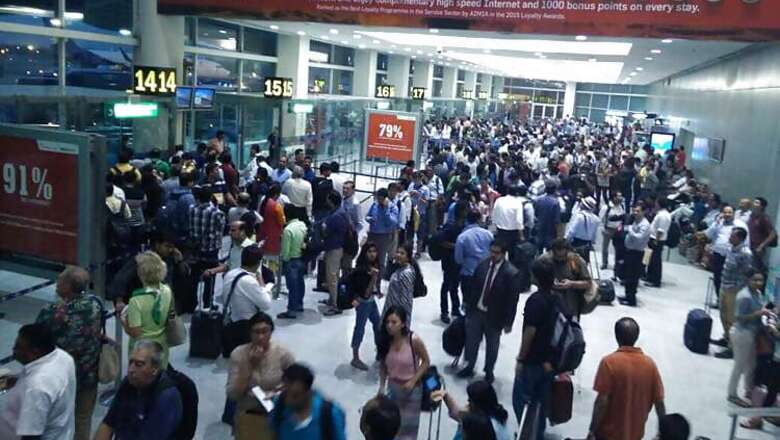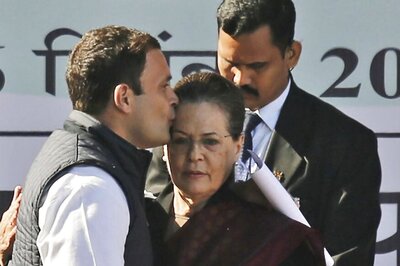
views
Propelled by a burgeoning middle class, better connectivity between cities, paucity of time and falling fares, air travel has grown by leaps and bounds in the last few years in India. With more planes taking off and landing at Indian airports, the demand for bigger and better facilities, too, has increased manifolds.
Delhi's Indira Gandhi International (IGI) Airport is often touted as one of the best and most modern complex of its kind in the country. It handles hundreds of aircraft and several thousand passengers daily but just like most infrastructure projects in India, it is also inadequately equipped to handle the massive rush and lacks facilities despite being one of the top airports in the country.
In May 2015, the IGI Delhi Airport saw its highest ever turnover of passengers with more than 4 million people travelling through domestic and international terminals. The main reasons attributed to this huge number are summer vacations and disruption of rail traffic due to the Gujjar agitation in Rajasthan which led to cancellation of many trains between national capital New Delhi and financial capital Mumbai.
While large number of passengers taking flights is a welcome sign and points towards a robust economy, it has also exposed the lack of facilities and infrastructure leading to a lot of inconvenience to the air travellers.
The problem is extremely acute at IGI's domestic terminal 1D which is bursting at seems and is not able to cater to such a huge rush especially in morning and evening hours when most of the flights land and take off.
Till February 26, 2009 Delhi's domestic terminal was known as Palam when the refurbished and modern version known as 1D was inaugurated. With 1D the capacity of domestic terminal increased to 10 million passengers per annum. As passenger demand rises, GMR plans to develop the airport further adding more terminals and runways to finally have a capacity to handle 100 million passengers per annum.
In spite of massive investment and development, lack of proper planning means 1D is not able to handle a much smaller number of travellers resulting in chaos, confusion, heated exchange of words between passengers on one side and security personnel, airlines and airport staff one the other side.
Security queues at 1D take about an hour or more to clear as there is a lack of Central Industrial Security Force (CISF) personnel who are tasked with the responsibility of providing security to the airport. They also act as the first point of interaction with the passengers who come to board a flight.
While lack of CISF personnel is a big bottleneck at almost all major airports in the country, in Delhi the problem becomes much more serious when over 4 million people use the airport in a month. CISF is critical to run any airport operation and on an average one passenger will pass through five CISF personnel during one departure.
The passenger comes face to face with CISF personnel at:
1. Main entry gate
2. Check-In gate
3. Security X-Ray
4. Physical frisking
5. Boarding gate
An adequate number of CISF personnel is an absolute necessity to handle the increasing number of passengers and providing foolproof security. However, senior CISF officials, without wanting to be quoted say that the working conditions for them are not very good. At times their salary is delayed by couple of months and very often their shifts stretch to more than 12 hours. Lack of manpower and long working hours ensure that most of the CISF personnel do not even get proper rest and are stressed out.
While the authorities are concerned, they seem helpless to provide any immediate relief to the harried passengers. There seems to be a total lack of strategy in addressing the challenges which must be done on a war footing if authorities really want to handle the traffic that Indian airports will see in the coming years.
GMR, responsible for maintaining and managing the Delhi airport, should be the most concerned amongst all.
In March 2010, Delhi International Airport (P) Limited (DIAL) also completed the construction of integrated passenger terminal called Terminal 3 (T3) which handles international passengers apart from some domestic flights too. According to DIAL, the first phase is capable of handling 60 million passengers per annum. While T3 is a much better equipped terminal, 1D faces serious challenges. Even after months of renovation and upgrade, 1D still lacks the desired facilities.
The domestic terminal remains extremely congested and is not able to handle sudden increase in passenger flow. The security queue area itself is very badly managed. A source says congestion and long security queues actually result in loss to GMR. When asked to explain the source says that since passengers spend more time in security checks after which they are exhausted and want to board the flight as quickly as possible, so they head straight towards boarding gates without bothering to eat or buy in the waiting lounge which results in loss of business.
But the ordeal of passengers at 1D does not end with security check. They have to still board the plane. The harried passengers then find that boarding gates at 1D are another concern area. There is very little space as hundreds of passengers crowd the area at any given point of time, waiting to board the flight. With space being a major constraint, it is absolute chaos and several passengers take the wrong queue only to be told at the last moment that they should be at some other gate.
To ensure better facility and more space GMR wants to extend the gates to about 25 feet ahead of where they presently are but the strange challenge is that no contractor is ready to take this job. One contractor who got the job assigned did not even start the work and simply ran away. Others are not picking it up, looking at the complexity involved. No wonder GMR Chairman GM Rao has made some surprise visits to Delhi airport to take stock of the problems and challenges.
With India projecting itself as an emerging world power and Delhi a major business and tourist destination especially for those coming from abroad, a solution needs to be found soon to ensure a better equipped airport before things start falling apart resulting in more chaos and more trouble for passengers.
Ranking of airports in India in terms of passenger traffic:

















Comments
0 comment